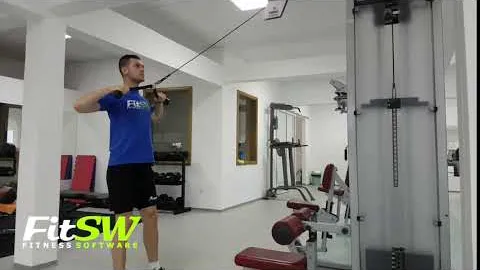

If you're looking for an effective exercise to target your rear deltoids, upper back, and shoulders, look no further than the Cable Rope Rear Delt Row. This compound exercise primarily engages the rear deltoid muscles, which often go unnoticed and undertrained. Adding this exercise to your workout routine can not only improve your overall shoulder strength and stability but also enhance your posture and prevent injury.
Before diving into how to perform the Cable Rope Rear Delt Row, let's take a closer look at the anatomy it targets. The rear deltoids, also known as the posterior deltoids, are the muscles located at the back of your shoulder joint. These triangular-shaped muscles play a crucial role in shoulder abduction (moving the arms away from the body), external rotation, and scapular retraction (pulling the shoulder blades together).
Additionally, the Cable Rope Rear Delt Row also engages the rhomboids and trapezius muscles, which are key players in shoulder blade retraction. Strengthening these muscles can help improve your posture and reduce the risk of developing shoulder-related issues.
Targeted Muscle Development: The Cable Rope Rear Delt Row is a proven exercise for isolating and developing the rear deltoid muscles, resulting in improved shoulder aesthetics and overall upper body strength.
Posture Improvement: As mentioned earlier, this exercise targets the muscles responsible for scapular retraction. Strengthening these muscles can help correct rounded shoulders and promote proper alignment, leading to better posture.
Balanced Shoulder Development: Many people tend to focus more on the anterior (front) deltoids due to their visibility. The Cable Rope Rear Delt Row allows you to balance your shoulder development by targeting the often overlooked rear deltoids.
Injury Prevention: Strong rear deltoid muscles provide stability to the shoulder joint and contribute to optimal shoulder mechanics. Regularly incorporating this exercise into your routine can help prevent injuries and improve shoulder function.
Follow these step-by-step instructions to properly perform the Cable Rope Rear Delt Row:
Setup: Start by attaching a rope handle to a low cable pulley. Adjust the height of the pulley so that it is at or slightly below knee level. Stand facing the cable machine with your feet shoulder-width apart, knees slightly bent.
Grip: Grasp the rope handles with an overhand grip. Your palms should be facing each other. Maintain a slight bend in your elbows throughout the exercise.
Starting Position: Stand tall, engage your core, and retract your shoulder blades, maintaining a flat back. This will be your starting position.
Execution: Initiate the movement by retracting your shoulder blades and pulling the rope handles towards your body, keeping your elbows close to your sides. Focus on squeezing your rear deltoids as you pull the handles towards your midsection.
Full Contraction: When the rope handles reach your midsection, squeeze your shoulder blades together and hold the fully contracted position for a brief moment, emphasizing the engagement of your rear deltoids.
Reverse the Movement: Slowly extend your arms forward, returning to the starting position while maintaining control throughout the entire range of motion.
Repetitions: Aim for 10-12 repetitions per set. Start with a weight that allows you to maintain proper form and gradually increase the resistance as you become stronger and more comfortable with the exercise.
Sets and Rest: Perform 3-4 sets of Cable Rope Rear Delt Rows, resting for 60-90 seconds between sets.
To add variety and challenge to your Cable Rope Rear Delt Row workout, consider the following variations:
Single-Arm Cable Rope Rear Delt Row: Perform the exercise using one arm at a time, alternating between left and right in each set. This variation helps identify and correct any muscular imbalances between your shoulders.
Supine Incline Cable Rope Rear Delt Row: Adjust a weight bench to an incline position and lie face up. Perform the Cable Rope Rear Delt Row while lying on the bench, emphasizing squeezing your shoulder blades together.
When performing any variation of the Cable Rope Rear Delt Row, keep these tips in mind:
The Cable Rope Rear Delt Row is a highly effective exercise for strengthening the rear deltoid muscles, upper back, and shoulders. By incorporating this exercise into your training routine, you can achieve better shoulder aesthetics, improve posture, and reduce the risk of shoulder injuries.
Remember to start with lighter weights and focus on proper form before progressing to heavier loads. As with any exercise, consult with a fitness professional if you have any concerns about your ability or technique.
Make Cable Rope Rear Delt Row a staple in your workouts and witness the positive impact it can have on your upper body strength and shoulder health.
If you're looking for a gym, fitness club or yoga studio, you've come to the right place.
You can find information about gyms in your area. Browse catalog of gyms and find gyms with classes which are you looking for.
On gym page you can find simple information like address, phone or website. You can find list of available classes. You can check availability of personal training or small group classes. On place page you can also see information about open hours.
You can find gyms near you with amenities, courts, studios and equipments.
Use our map to find gym at your city or district.
In Gym Navigator you can find list of exercises with movies for many body parts.
You can browse exercises catalog and find exercises the best of you.
You can also find exercises grouped into workout plans, which you can use to improve you body. Each routine show you exercises one by one and give you possibility to count you progress and count down rest time.